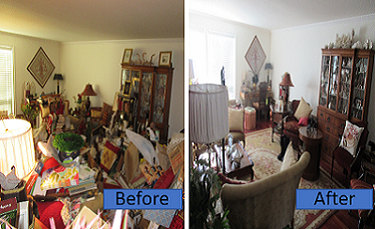Fairfax County does not provide services for mental/physical health care aspect of Hoarding Disorder. Therefore, these services must be accessed privately through personal health insurance plans. However, here is an overview of treatment options:
Intervention:
Individuals do not want help and are unwilling to change. The most important thing to understand is that if an individual with Hoarding Disorder DOES NOT want to change his/her lifestyle or behavior, then treatment is ineffective if forced upon them. It will not work or be successful, and it could damage your relationship with them if you try to push them in a direction that they are not ready to go. If this is your situation, please refer to the “When is Intervention Necessary” section above for next steps.
They Are Willing:
Individuals are ready for help and want a change. If you or someone you know has a living situation beyond their control and yet are open to a change, then the first step is for that individual to obtain insight into their own behavior. Next, they will need to find the mechanism or motivation to create change. However, neither insight nor motivation alone will change the long-term hoarding behavior. Instead, intensive professional treatment should be obtained. Treatment can help people with this disorder understand how their beliefs and behaviors must be changed to live safer and happier lives.
To get this end result, the private sector involvement is vital in the prevention and treatment of Hoarding Disorder. The professional, unbiased, unjudgmental approach often is the key to reaching afflicted individuals and focusing on their specific needs.
This includes:
- Finding and joining hoarding support groups, both for the client and the family
- Utilizing hoarding coaches to help build skills
- Hiring professional organizers to help classify things and do heavy disposing
- Contracting mental health clinics and private therapists
- Entering psychiatric rehabilitation programs
- Reaching out to religious groups for personal support of individuals and families
To understand the treatment options for hoarding behavior, it is first important to understand that people with Hoarding Disorder will battle this for most of their adult life. This is a chronic condition, which needs to be continually managed. The act of hoarding can affect relationships with friends and family and could cause individuals to feel isolated, alone or depressed. If the onset trigger for Hoarding Disorder included experiencing a traumatic event of serious loss or living through hardship, these underlying causes must be addressed as well as the hoarding behavior itself. Additionally, people with this disorder do not always see their behaviors as being a problem. This makes treatment very complex and challenging. Weekly therapy visits can extend into months or years and includes substantial habit-breaking homework. During these visits, many intensive interventions and techniques can be used to help manage this disorder through helping people understand how to change their beliefs and behaviors. Despite this sounding like an overwhelming process, the end result can be a return to a normal life which is socially enriching and again functional.
Treatment of Hoarding Disorder by private therapists and programs utilize a variety of strategies for a personalized treatment plan per individual.
These strategies can include from the following list:
- Using Medicine (i.e., anti-depressants) yields mixed results. For most people the use of medicine has not been found to be effective in treating hoarding behavior, as this behavior does not seem to be linked to neurological problems. It has been found useful, however, to help people relax during other therapy interventions making that type of therapy more successful.
- Coaching or Motivational Interviewing strategies improve a person’s motivation to create positive change.
- Skill or Tolerance Building Therapy sessions allow people who are tuned into their compulsivity or indecisiveness the ability to break up the pattern and alter the hoarding behavior. This is very helpful for people who are shop-a-holics or who might have difficulty throwing things away. For example, it may include trips to the store to not buy anything.
- Counseling Sessions allow people who have experienced a traumatic event evaluation and they are helped through a healing process. The purpose of this is for the person to gain insight into why they are reacting the way they are, doing the things they are doing, and then learning how to do things differently to gain a different outcome. For example, they will learn how to form relationships with people, so they do not have a need to love their possessions.
- Cognitive Behavioral Therapy is a combination of skill building and counseling combined, as hoarding is based on irrational thinking patterns that sustain the behavior. This treatment centers on challenging the irrational thoughts and substituting with reality-based thinking. In other words, a focus on skill-based learning leads to alterations in compulsive hoarding behavior. Some concentrations for this therapy include:
- Challenging the hoarder’s beliefs/needs to keep everything
- Going out without bringing home new items, including free items
- Independently removing clutter, donating, or recycling, and organizing what remains
- Developing a plan to prevent recidivism. For more information about the various therapy techniques, please visit the International OCD Foundation.
 Do you experience any of the following symptoms?
Do you experience any of the following symptoms?

 If you have tried an intervention yourself by approaching someone with Hoarding Disorder and were not successful OR you know someone that has a problem but you don’t know how to help, there are local county agencies that can be of assistance. Houses on the verge of collapse, or where adults, children, or animals are being neglected or abused may require emergency interventions. Additionally, local authorities can be the catalyst for change to help an individual receive the help and/or treatment needed to return to a normal, safer lifestyle.
If you have tried an intervention yourself by approaching someone with Hoarding Disorder and were not successful OR you know someone that has a problem but you don’t know how to help, there are local county agencies that can be of assistance. Houses on the verge of collapse, or where adults, children, or animals are being neglected or abused may require emergency interventions. Additionally, local authorities can be the catalyst for change to help an individual receive the help and/or treatment needed to return to a normal, safer lifestyle. 
